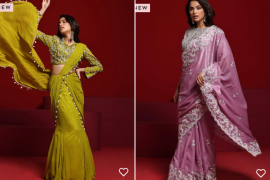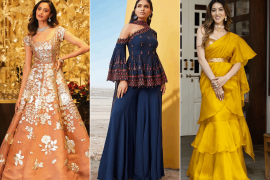When it comes to weddings, there are a lot of decisions you’ll have to make. Whether you’re going for an elegant venue or a more rustic barn wedding, whether you want your bridesmaids in red or blue, and whether you want your cake to be vanilla or chocolate—you’ll have a lot of choices.
But one decision that’s not optional is deciding on the wedding ring. After all, the ring symbolizes your love, and it’s something you’ll wear every day. Buying a wedding or Gemstone Engagement Ring can be a daunting task for prospective grooms. There are so many decisions to make, and the stakes are high — it’s likely the most expensive piece of jewelry you’ll ever purchase.

So Here Are Five Tips To Help You Find The Perfect One:
1. Know Your Budget
The first step is to set a budget. It’s easy to get caught up in the emotion of ring shopping and spend more than you intended. Before you start looking, sit down with your significant other and figure out how much you’re comfortable spending. Once you have a number in mind, you can narrow down your options.
There are many factors that contribute to the price of a wedding ring, including the size and quality of the stone, the setting, engravings, and more. With a pre-set budget, you know what to look for and can avoid being pushed into buying something outside of your price range.
2. Consider Her Style
Does your partner prefer dainty jewelry or statement pieces? Look at the type of jewelry she wears daily. If she prefers simple and delicate pieces, you’ll want to find something similar. If she loves to stand out, look for a wedding or engagement ring with a unique setting or an unusual stone.
No matter her style, the ring should be something she’ll want to wear every day. After all, it’s not just a symbol of your love—it’s also a piece of jewelry she’ll be wearing for the rest of her life.
So, when browsing rings, consider whether or not she would be happy wearing it with a t-shirt or dressed up for a night out on the town. Some rings are more casual than others, so make sure to factor in her lifestyle when choosing.
3. Look at Gemstones
Speaking of gemstones, if you decide on one instead of a diamond ring, there are some things to remember when choosing a particular gemstone. First off: color! While diamonds traditionally are colorless and range from clear-white to yellowish-brown depending on quality, gemstones come in pretty colors.
If you want your partner to have a birthstone ring, that’s also an option. However, some birthstones, like pearls, are less durable than others and may not stand up to daily wear as well as a diamond would. You’ll also want to keep in mind the gemstone’s hardness—the harder the stone, the more resistant it is to scratches. Emerald, yellow sapphire, or ruby can be excellent choices in this regard.
You might be tempted to go for a larger stone when ring shopping, especially if you’re on a tight budget. But remember: it’s better to have a smaller, high-quality stone than a large, low-quality one.
The sales staff at diamond jewelry stores are trained professionals who know how to answer questions about diamonds and gemstones. You may feel embarrassed asking about specific details like cut quality or clarity grades, but remember: they’ve heard it all before! Don’t hesitate to ask any questions during your search for a wedding ring—make sure they’re within your budget.

4. Choose the Right Metal and Settings
The metal and setting of an engagement ring are just as important as the stone. The most popular metals for rings are yellow gold, white gold, platinum, and silver.
Of course, you’ll want to take your partner’s style into account when choosing a metal. If she loves dainty jewelry, a thin band in white gold or platinum would be a good choice. If she prefers bolder pieces, you might want to go for a yellow gold ring with a more intricate setting.
The setting is the part that holds the gemstone in place. The most popular settings are prong, bezel, and tension.
Prong settings are the most popular and feature metal “claws” that hold the stone in place. Bezel settings are a good choice if you want a more minimalist look, as they feature a metal band that goes around the stone. Tension settings are a newer option and use tension to hold the stone in place—hence the name.
Also, make sure that your ring is resizable if possible because one day down the line, it might not fit anymore after weight gain or loss due to pregnancy, etc. You want something that can accommodate any changes in size over time without being too expensive!
5. Choose the Right Seller
Once you’ve decided on the perfect ring, it’s time to find a reputable seller. The best way to do this is by asking for recommendations from friends or family members who have recently purchased jewelry.
If you don’t know anyone who has bought jewelry recently, you can also check out online reviews. Pay attention to both the positive and negative reviews to get a well-rounded idea of what the seller is like. Once you’ve found a few potential sellers, it’s time to start shopping around. Compare prices and policies between different stores to find the best deal.
Keep in mind that you’ll get what you pay for when it comes to wedding rings. If you buy a ring from a super cheap store, the quality won’t be as good as a more expensive ring from a reputable seller.
Also, remember that you can always negotiate! If you find a gemstone engagement ring that you love, but it’s out of your price range, see if the seller is willing to give you a discount. It never hurts to ask. Stores like GemPundit offer excellent varieties with great prices, making it easier for the buyer. They have an easy return policy, and every gemstone comes with a free lab certificate proving its authenticity.
Do some research, so there are no surprises when it comes time to pay for the product – make sure all of their policies align with yours before making any purchases.













Comments are closed.